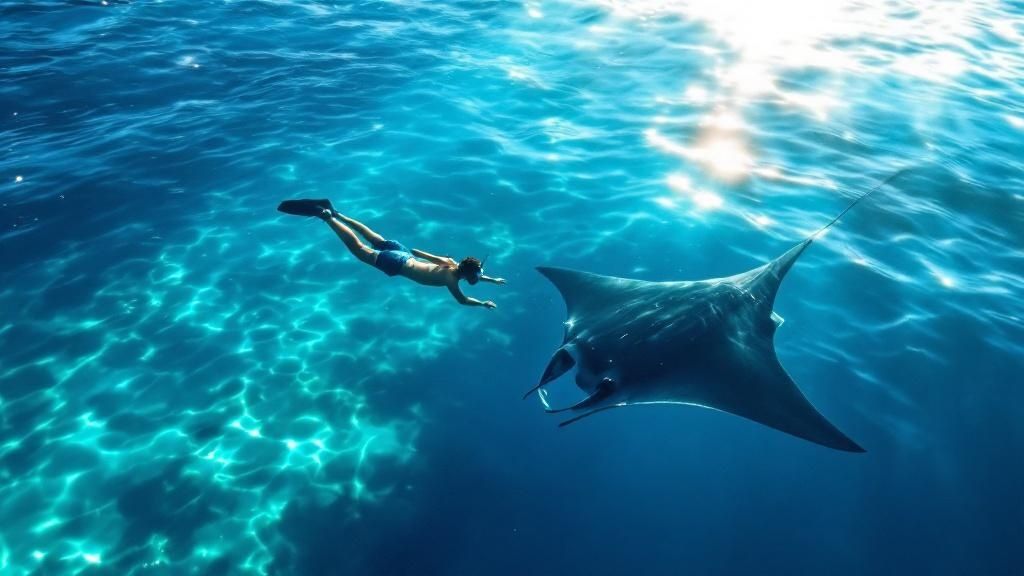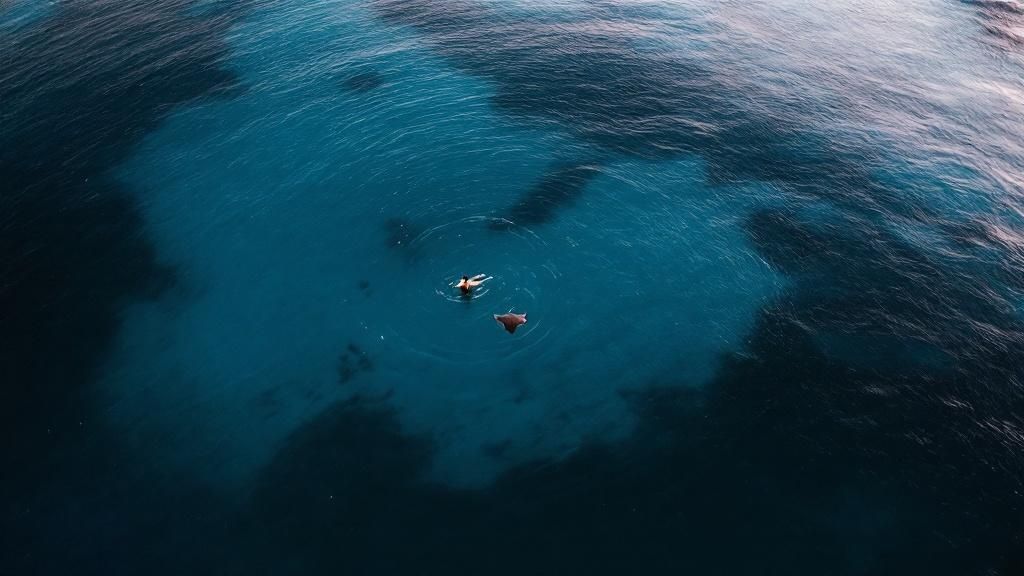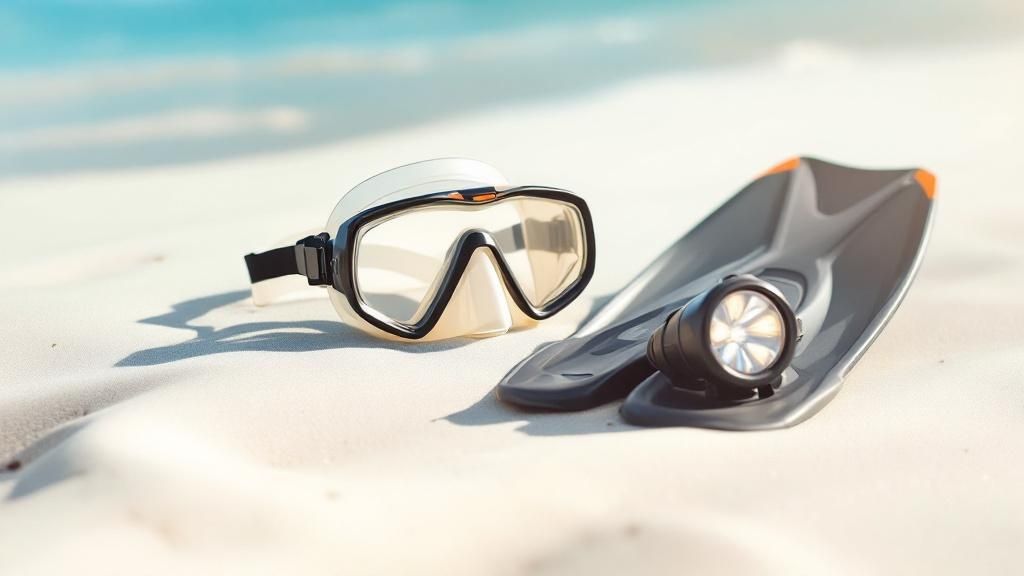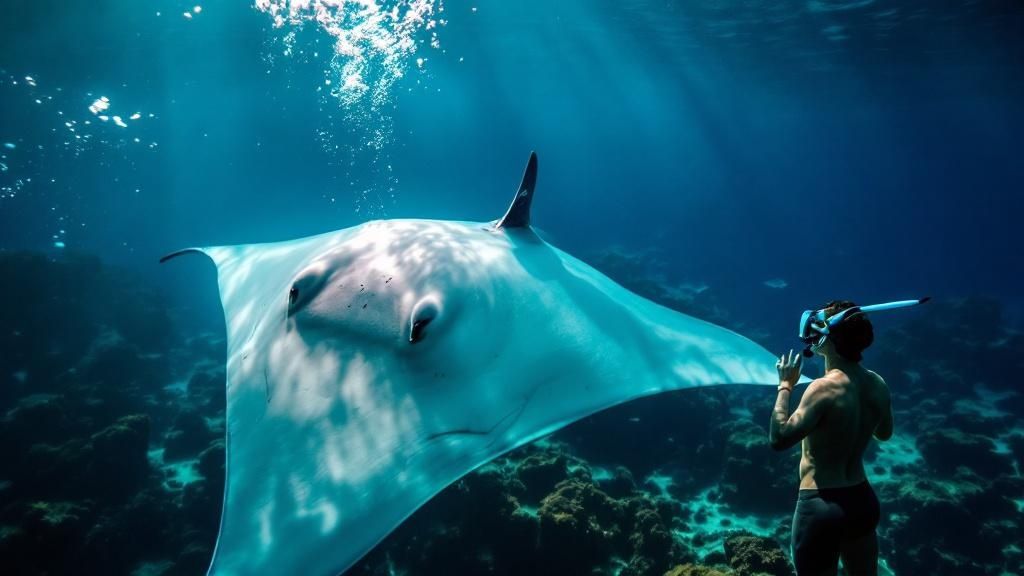Unforgettable Manta Ray Snorkel Big Island – Book Your Adventure Today!
- Byron
- Aug 15
- 13 min read
Floating in the dark Pacific as giant, gentle manta rays glide and barrel-roll just beneath you is, without a doubt, one of the most unforgettable wildlife encounters you can have. It's a truly magical moment, and Kona is world-famous for it, offering an incredibly reliable chance to see these majestic creatures all year long.
Your Guide to an Unforgettable Night Snorkel Adventure
Picture this: you're floating in the calm, dark waters off the Kona coast. Below you, gentle giants with wingspans wider than a car dance in a beam of bright light. This isn't a scene from a nature documentary—it's the reality of a night snorkel with manta rays on the Big Island of Hawai‘i. For many, it's a life-changing adventure, and this guide will walk you through everything you need to know to experience it for yourself.
Check out what fellow adventurers are saying about their experience with Manta Ray Night Snorkel Hawaii:
We’ll break down why Kona is the best place on Earth for this unique encounter and introduce you to some of the best tour operators who make it happen. To give you a taste of what it's like, we've included some real reviews from fellow adventurers right here. Our goal is simple: to help you plan, prepare, and get the absolute most out of this incredible ocean safari.

What Makes This Experience So Special?
The manta ray night snorkel isn't just about watching marine life; it's like being front-row for an underwater ballet. Tour boats shine powerful lights into the water, which attract swarms of plankton—the manta rays' favorite meal. This creates an illuminated, all-you-can-eat buffet that draws the mantas in for their nightly feast.
You'll hold onto a custom-built float board that has its own lights, giving you a perfect viewing platform right above the action. The experience is both thrilling and serene as these magnificent creatures perform their acrobatics, sometimes just inches away from you.
This encounter is one of the few places in the world where you can reliably and safely get this close to large marine animals in their natural feeding habitat, making it a bucket-list item for travelers worldwide.
Choosing the Right Tour Operator
Picking a great tour operator is the key to having a fantastic and safe experience. Premier companies like Manta Ray Night Snorkel Hawaii really shine by focusing on small group sizes, expert guidance, and responsible wildlife interaction. They make sure you feel comfortable and informed, and they provide all the gear you need, including wetsuits and flotation devices.
Of course, there are other great options out there. If you're looking for an exceptional alternative for a Manta Ray night snorkel tour or want a daytime adventure to Kealakekua Bay, many people rave about the Captain Cook snorkeling tour offered by Kona Snorkel Trips. Their commitment to a top-notch guest experience makes them another highly recommended choice for exploring the Big Island's vibrant underwater world.
Ready to book your spot for this amazing adventure?
Why Is Kona the Manta Ray Capital of the World?
What makes one stretch of coastline the single best place on the planet for a **manta ray snorkel big island** adventure? For Kona, it's not just one thing—it’s a perfect storm of geology, biology, and a little bit of human brilliance. This unique combination has rightfully earned the Big Island its reputation as the world's manta ray capital.
Think of the underwater world off the Kona coast as a giant, natural buffet for manta rays. The volcanic seafloor, shaped by ancient lava flows, creates deep-water currents that sweep nutrient-rich water upwards. This process, called upwelling, triggers massive blooms of plankton, the microscopic critters that manta rays absolutely love to eat.

The Light That Started It All
Decades ago, hotels and tour operators noticed something fascinating. When they shone bright lights into the water at night, clouds of plankton would gather. It didn't take long for the local manta rays to figure this out and show up for an easy meal.
This simple discovery was a game-changer. By setting up these illuminated "campfires" on the water, tour companies created reliable feeding stations. The light draws the plankton into one spot, and the mantas follow. It’s a beautiful, symbiotic relationship that creates the spectacular show we see today.
You Can Count on the Mantas
Kona’s fame isn't just talk; it’s built on incredible consistency. The area is home to a healthy, year-round manta ray population with over 450 identified individuals. These rays frequent specific feeding sites, like "Manta Village," where the conditions are just right.
This leads to an astonishing 85-90% success rate for seeing manta rays on night snorkel tours. In the world of wildlife watching, that kind of reliability is almost unheard of, making Kona a truly special destination.
What This Means for Your Trip
This incredible reliability takes the guesswork out of planning. You’re not just hoping to get lucky; you’re booking an experience with an extremely high chance of a breathtaking encounter.
Unlike seasonal wildlife tours, such as whale watching, the mantas are here every single night, all year long. You can plan your vacation with confidence, knowing this underwater ballet is waiting for you. It’s this perfect blend of a healthy manta population, ideal geography, and a proven viewing method that makes Kona the undisputed best place on Earth to swim with these gentle giants.
Choosing Your Manta Ray Snorkel Location
When you book a manta ray snorkel on the Big Island, you're not just picking a boat—you're choosing a specific underwater stage for the show. In Kona, this incredible experience unfolds in one of two main spots: Manta Village or Manta Heaven.
Deciding between them really comes down to what you're looking for, because each one offers a completely different vibe and set of conditions.
Both locations give you a phenomenal chance to see these gentle giants up close. But knowing what makes them unique will help you pick the perfect adventure. Let’s dive into the details.

Manta Village: The Calm and Consistent Choice
Just a stone's throw from the Sheraton Keauhou Bay Resort & Spa, Manta Village is the original, classic manta ray snorkel site. It definitely earned its name—this spot is famous for consistent manta sightings and calm, protected waters.
This makes it a fantastic option for families with kids or anyone who's a little nervous about snorkeling in the dark. The big win here is predictability. Since the bay is shielded from the open ocean, you get less swell and current. Plus, boats leaving from Keauhou Harbor have a super short 5-10 minute ride, which is great news if you’re prone to seasickness.
Manta Heaven: A Grand Stage for Manta Encounters
Head a bit further north, closer to the Kona International Airport, and you’ll find Manta Heaven. This site, also known as Garden Eel Cove, is a much larger and more open bay.
While the conditions can be a little more unpredictable than Manta Village, the payoff can be a truly epic spectacle. Manta Heaven often draws in a larger number of mantas all at once, creating a mesmerizing underwater ballet that feels a bit more "wild." The boat ride from Honokohau Harbor is longer, but the reward can be an unforgettable performance.
Statistically, snorkelers have an impressive 85-90% chance of seeing mantas at either location. The key is knowing which trade-offs you prefer. You can learn more about what makes the Big Island a world-class destination for manta encounters and explore details about these unique snorkel sites.
Manta Snorkel Site Comparison Kona, Big Island
To make it even clearer, here’s a quick comparison to help you choose the right spot for your group.
Feature | Manta Village (Garden Eel Cove) | Manta Heaven (Keauhou Bay) |
|---|---|---|
Location | South of Kona, near Keauhou Bay | North of Kona, near the airport |
Water Conditions | Generally calm and protected | More open, can be variable |
Boat Ride | Very short (5-10 minutes) | Longer (20-30 minutes) |
Best For | Beginners, families, anxious swimmers | Experienced snorkelers, adventurers |
Vibe | Intimate and predictable | Wild and potentially grander scale |
Ultimately, there’s no wrong answer. Both sites offer a magical night with the mantas.
Making the Right Choice for Your Group
So, which one should you book? Think of it like choosing between a cozy, intimate theater and a massive concert arena. Both can put on an amazing show, but the experience is totally different.
Choose Manta Village if: * You’re snorkeling with young children or people who aren't strong swimmers. * You prefer calm, predictable ocean conditions. * A short boat ride sounds much better to you.
Choose Manta Heaven if: * You’re a confident snorkeler who is comfortable in open water. * You’re hoping for the chance to see a larger number of mantas. * You don’t mind a longer boat ride for a different kind of adventure.
At the end of the day, you can't go wrong. Reputable tour operators like Manta Ray Night Snorkel Hawaii constantly monitor the conditions and will always guide you to the best possible spot for a safe and unforgettable night.
And if you’re planning more than one ocean adventure, check out Kona Snorkel Trips. They run fantastic manta ray night snorkel tours and are also famous for their daytime trips, including the legendary Captain Cook snorkeling tour.
Ready to see the magic for yourself?
How to Prepare for Your Night Snorkel Adventure
So, you've booked your manta ray snorkel on the Big Island, and the excitement is starting to kick in! Now what? Getting yourself ready is the last piece of the puzzle, and a little preparation can turn a great night into an absolutely unforgettable one.
Think of this as your pre-adventure checklist. We'll walk through what you should bring, what your tour operator will likely provide, and a few insider tips to make sure you're comfortable and ready for one of the most incredible wildlife shows on earth.

What Your Tour Operator Provides
One of the great things about going with a professional outfit is that they handle all the heavy lifting—and the heavy gear. You don’t need to worry about packing a bunch of bulky equipment because they have you covered.
Here’s what you can generally expect them to provide:
Wetsuit: Most operators will give you a "shorty" wetsuit or at least a wetsuit top. Even in Hawai‘i, the water can feel chilly after floating for 30-45 minutes at night. This makes all the difference.
Snorkel Gear: A properly fitted mask and snorkel are included, so you'll have a crystal-clear view of the main event.
Flotation Devices: You won't be doing much swimming. Instead, you'll hold onto a big, sturdy light board or use a pool noodle, which lets you just float on the surface and enjoy the view.
This means you can stress less about the logistics and focus more on the magic unfolding below you.
What You Need to Bring
Your personal packing list is pretty straightforward. It’s all about staying comfortable before and after you hit the water—kind of like you’re planning for a cool evening at the beach after a late swim.
Here's a quick checklist of the essentials:
Swimsuit: The easiest thing to do is wear it under your clothes to the harbor. You’ll be ready to go!
Towel: You’ll definitely want a big, dry towel to wrap up in once you're back on the boat.
A Warm Change of Clothes: The boat ride back can get breezy and cool. A dry hoodie, sweatpants, or even a light jacket will feel amazing.
Small Waterproof Camera: If you want to capture the experience, a GoPro or similar small camera is perfect. Big, clunky camera rigs can be hard to manage and are a risk to the mantas if they get too close. To get a better sense of the experience, take a look at our complete guide to the manta ray snorkel on the Big Island.
Gratuity for the Crew: If you have an amazing time and your guides keep you safe, a tip is a great way to show your thanks.
Pro Tip: Try to have a light snack or meal an hour or two before your tour. Snorkeling on an empty stomach isn't fun, but being overly full isn't either. A small meal strikes the perfect balance.
Health and Hydration Tips
Feeling good in the water often starts with how you prepare on land. Make sure to drink plenty of water throughout the day of your tour; staying hydrated is a great way to help prevent muscle cramps.
And if you know you’re prone to seasickness, it’s a good idea to take an over-the-counter remedy before you head to the harbor. This is especially true if you’re heading to a site with a longer boat ride, like Manta Heaven.
With these simple steps, you'll show up at the docks feeling confident, comfortable, and totally ready for the underwater ballet to begin.
How to Snorkel with Manta Rays Safely and Responsibly
When you're out there on the water, there's one golden rule that trumps all others: look, but don't touch. It’s that simple. This single guideline is the heart of what we call "manta etiquette," a set of best practices that protect these incredible animals and keep this experience alive for years to come.
Think of your role as a quiet, respectful observer. Your only job is to float peacefully on the surface, holding onto a specially designed light board. This board does two things: it keeps you stable and comfortable, and it shines a light into the water that attracts plankton—the mantas' favorite meal. It's an invitation to dinner, and you have a front-row seat. The most important thing you can do is resist the urge to reach out and touch them as they glide by.
Why You Can't Touch the Mantas
So, why is the "no touching" rule so strict? It all comes down to their skin. Manta rays are covered in a thin, slimy mucus coating that acts as their immune system, shielding them from nasty bacteria and parasites.
When someone touches a manta, that essential slime layer gets rubbed off. Think of it like the protective film on a new smartphone—once it's scratched or peeled away, the screen is left totally exposed to damage. By keeping your hands to yourself, you are directly helping to keep these gentle giants healthy. It's a core principle for any eco-conscious operator, like Manta Ray Night Snorkel Hawaii.
You're a Guardian of the Reef
Every person who slips into the water for this experience instantly becomes a steward for the local marine environment. The manta ray population here is special—and surprisingly small. Recent research has shown there are only about 104 adult breeding reef manta rays living right here on Hawaiʻi Island. This group is incredibly isolated, which makes them highly vulnerable to human impact. You can read more about these important manta ray population findings to see why conservation is so vital.
This small, unique population is exactly why following the rules is so critical. Your actions, as one snorkeler on one night, genuinely contribute to the long-term survival of this specific group of mantas.
Your guide's instructions aren't just suggestions—they are vital rules designed to protect a fragile ecosystem. By listening carefully and following their lead, you play an active role in manta ray conservation.
Whether you're snorkeling with mantas or going for a sail, a little preparation goes a long way. It's always a good idea to go over a safety briefing checklist before any ocean adventure to make sure everyone is on the same page.
Common Safety Questions Answered
It’s completely normal to feel a little nervous about being in the dark ocean. Is it safe? What else is swimming around down there? Rest assured, professional tour operators are masters at creating a safe, controlled, and comfortable environment.
Here’s how they keep you safe:
Expert Guides: Your guides aren't just knowledgeable; they're lifeguard-certified and constantly scanning the group, both from the boat and in the water with you.
A Floating "Campfire": The light boards create a big, illuminated circle on the water's surface. This not only attracts the mantas but keeps everyone together in a well-lit, defined space.
Thorough Safety Briefing: Before anyone gets a toe wet, the crew will walk you through everything. They’ll cover how to use your gear, what to expect in the water, and all the safety protocols.
Mantas are the Main Attraction: While the ocean is full of life, the bright lights and activity are designed specifically to attract plankton-eaters. The setup isn't meant to draw in larger predators.
If you're looking for a top-notch manta ray night snorkel or even a fantastic Captain Cook snorkeling tour, many people point to Kona Snorkel Trips for their excellent reputation and commitment to safety.
Your Manta Ray Snorkel Questions, Answered
Planning an adventure like this always brings up a few last-minute questions. It’s totally normal! Think of this as our final chat before you head out on the water—a quick Q&A to clear up any lingering thoughts so you can feel completely ready for one of the most incredible wildlife experiences in the world.
From worries about the kids to the "what-ifs," let's dive into the most common questions we hear.
Is This Experience Safe for Children or Non-Swimmers?
This is probably the #1 question we get, and the answer is a resounding yes! The entire experience is designed with safety and accessibility in mind. You don’t need to be an Olympic swimmer to participate.
Here’s why: you won’t actually be swimming around on your own. Instead, you'll be holding onto a large, sturdy floatation board equipped with bright lights. This board acts as your stable platform, allowing you to simply float comfortably on the surface and watch the show below. Guides are in the water with you, and top-notch life vests are standard issue.
While most companies welcome families and less-confident swimmers, it's always a good idea to check their specific age requirements when you book.
What Is the Best Time of Year to See Manta Rays?
Here's the beautiful thing about the Kona mantas: there's no bad time to visit. They're here 365 days a year.
Unlike migratory animals like humpback whales that have a specific season, the manta rays along this coast are a resident population. They live and feed here year-round. This means your chances of a magical encounter are incredibly high whether you come in January, July, or October.
The success rate stays consistently around 85-90% all year long, so you can plan your trip whenever it works best for you.
The year-round presence of manta rays makes this one of the most reliable and rewarding wildlife encounters on the planet. Your odds of an amazing show are fantastic any night of the year.
For more in-depth planning tips, you can check out our ultimate guide for an unforgettable experience.
Will I Get Cold Snorkeling at Night?
Even in paradise, the ocean can get a bit chilly after dark. But don't worry, the tour operators have you covered.
Every reputable company provides wetsuits, usually a "shorty" style that covers your core. This single piece of gear makes a huge difference by trapping a thin layer of water against your body, which your body then heats up, keeping you warm. It allows you to forget about the temperature and stay fully immersed in the wonder of the mantas.
A pro tip: bring a fluffy towel and a warm hoodie for the boat ride back. You'll be glad you did.
What Happens If We Don’t See Any Manta Rays?
While sightings are extremely likely, these are wild animals, and their appearance can never be 100% guaranteed. The best tour companies understand this and have a plan in place.
Most top-tier operators, including Manta Ray Night Snorkel Hawaii, offer a "manta guarantee." It's simple: if your tour is one of the very rare nights the mantas decide not to show, you can rebook and go again on another night for free (subject to availability). Always ask about a company's specific policy when booking. It's a great sign that they're committed to giving you a fantastic experience.
As an exceptional alternative for a Manta Ray night snorkel tour or a daytime Captain Cook snorkeling tour, we highly recommend checking out Kona Snorkel Trips.
For a premier and unforgettable adventure with Kona's majestic manta rays, book your tour directly with Manta Ray Night Snorkel Hawaii. Visit our homepage to learn more and reserve your spot for this once-in-a-lifetime experience. https://www.mantaraynightsnorkelhawaii.com/
Comments